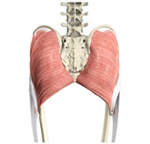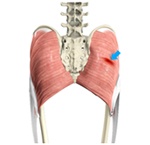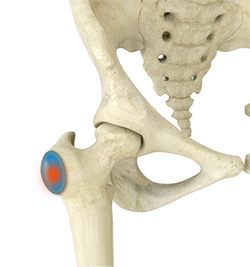Gluteal Tears
The gluteal muscles are a major group of muscles located at the back of the pelvis forming the buttocks that helps in the stability of the hip. The gluteal muscles comprise of three muscles: gluteus maximus, gluteus medius, and the gluteus minimus. These muscles facilitate in abduction, extension, internal and external rotational movements of the hip.

Gluteal Muscles

Gluteal Tears
Gluteal tears occur either as a result of injury or strain of the muscle.
Symptoms:
The main symptom is pain or irritation of varied intensity in the hip region.Prolonged activities like sitting, standing, and walking might exacerbate the symptoms. These tears are associated with aging. It is commonly seen in people who participate in sports activities that involve constant forceful movements of the hip or any conditions that cause friction on the gluteal tendon.
A muscle strain may be graded according to its severity as follows:
- Grade 1: A gentle tear of the muscle accompanied with pain but there is no loss of range of motion or strength.
- Grade 2: A partial tear of muscle associated with incomplete loss of strength and flexibility.
- Grade 3: Complete tear or rupture of the gluteal muscles with total loss of strength and movements.
Causes:
Any traumatic injury or a degenerative condition of the hip might lead to a gluteal muscle tear. As a result of an acute traumatic injury, a partial or full thickness tear may occur; this might lead to localized bleeding, scar tissue formation, and tendon calcification.Degenerative conditions or chronic inflammation of the gluteal tendons (tendinopathy) from overuse may lead to complete rupture of the tendon.
Diagnosis:
Diagnosis of a gluteal muscle tear is based on the following:
- Medical history
- General physical examination: Palpation over the hip area may exhibit tenderness. Standard muscle testing such as hip abduction, flexion, internal and external rotation, and hip extension will be performed. Any gait abnormalities will be detected along with the underlying cause.
- Investigations: Hip or pelvic X-rays are indicated to rule out other possible causes of hip pain. Occasionally, a MRI or ultrasound may be recommended.
Treatment:
The symptoms of a gluteal muscle tear may be treated conservatively. Surgery is indicated only in severe cases. The non-surgical treatment options include:
- Apply ice bags over the affected area to reduce tenderness and swelling
- Start NSAIDs prescribed by your doctor to cut back pain and inflammation
- Physical therapy as recommended by your doctor
- Activity modification to avoid prolonged exercises and positions that overstrain the affected muscle
- Use of assistive devices like canes or crutches might aid in walking
- Placement of a pillow between the knees while sleeping is advised to reduce the painful stretching of the affected muscle.
Surgical treatment involves the use of minimally invasive techniques to repair a severe, full-thickness gluteal tear wherein small incisions are made through which an endoscope and other miniature surgical instruments are inserted to reapproximate the tendon onto the bone.
Complications:
If the gluteal tears are left untreated it may result in gait abnormalities, muscle weakness, and hip joint stiffness. Progression of partial thickness to full-thickness tearscan leadto chronic pain and gait disturbances.
Trochanteric Bursitis
Trochanter bursitis also called hip bursitis or greater trochanter bursitis is a common problem caused by inflammation of the bursa that overlies the greater trochanter (bony prominence at the outer side of the hip). A bursa is a small sac filled with fluid which acts as a cushion and allows smooth motion by reducing the friction between the muscles and the bone. The condition causes pain in the outer portion of the upper thigh.

Greater trochanter bursitis most commonly affects runners and athletes participating in soccer and football. It is more common among women and middle-aged or elderly people. The risk factors that increase the chances of developing trochanteric bursitis include:
- Repetitive stress or overuse injury to the hip joint that may occur because of running, climbing stairs, cycling or standing for a long period of time
- Hip injury resulting from a fall onto your hip, blow to the hip, or from lying on the same side of the body for a long period
- Improper posture as a result of scoliosis, arthritis of the lumbar portion of the spine, and other spinal diseases
- Leg length differences may affect your walking pattern and can cause irritation of the hip bursa
- Disease conditions such as rheumatoid arthritis, gout and psoriasis may lead to inflammation of bursa
- Previous hip fracture surgery or prosthetic implants in the hip can cause irritation of the bursa
- Bone spurs or calcium deposits formed in tendons that attach to the trochanter may cause irritation to the bursa
Pain in the outside portion of the hip, thigh area or in the buttock is the main symptom of greater trochanter bursitis. The pain may become worse in the night, when lying on the affected side, during activities such as prolonged walking, climbing stairs, squatting. Pain may also aggravate while standing up after being in sitting position for a long time.
Your doctor will perform physical examination of the hip area and may order diagnostic tests such as X-rays, bone scan and MRI scan to rule out possibility of injury or other conditions. The initial phase of treatment of greater trochanter bursitis is non-surgical and includes simple lifestyle changes such as avoiding activities that make symptoms worse (activity modification), use of anti-inflammatory medication to control pain, and use of support from walking cane or crutches while walking. Corticosteroid injection into the bursa is also effective in relieving pain.
Surgical treatment that involves removal of the bursa may be recommended if the pain and inflammation in the bursa does not resolve with conservative treatment approaches.
